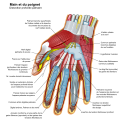Restr:Wrist and hand deeper palmar dissection-numbers.svg

Ment rakwel PNG ar restr SVG : 474 × 600 piksel. pizhderioù all : 190 × 240 piksel | 379 × 480 piksel | 607 × 768 piksel | 809 × 1 024 piksel | 1 619 × 2 048 piksel | 555 × 702 piksel.
Restr orin (restr SVG file, pizhder 555 × 702 piksel, ment ar restr : 207 Kio)
Istor ar restr
Klikañ war un deiziad/eur da welet ar restr evel ma oa da neuze.
| Deiziad/Eur | Munud | Mentoù | Implijer | Notenn | |
|---|---|---|---|---|---|
| red | 1 Mez 2015 da 17:15 |  | 555 × 702 (207 Kio) | Perhelion | optimize image |
| 8 Gou 2012 da 11:42 |  | 555 × 702 (399 Kio) | Wilfredor | optimize image | |
| 13 Gen 2009 da 21:11 |  | 555 × 702 (817 Kio) | Wilfredor | {{Information |Description= |Source= |Date= |Author= |Permission= |other_versions= }} | |
| 16 Her 2008 da 16:37 |  | 555 × 702 (815 Kio) | Wilfredor | {{Information |Description= |Source= |Date= |Author= |Permission= |other_versions= }} | |
| 23 Gou 2008 da 19:33 |  | 770 × 767 (822 Kio) | Bibi Saint-Pol | {{Created with Inkscape}} == {{int:filedesc}} == {{Information |Description= {{en|The hands (med./lat.: manus, pl. manūs) are the two intricate, prehensile, multi-fingered body parts normally located at the end of each arm of a human or other primate. Th |
Implij ar restr
Implijout a ra ar bajenn da heul ar restr-mañ :
Implij hollek ar restr
Ober a ra ar wikioù da-heul gant ar restr-mañ :
- Implij war af.wikipedia.org
- Implij war ar.wikipedia.org
- Implij war az.wikipedia.org
- Implij war bjn.wikipedia.org
- Implij war bn.wikipedia.org
- Implij war ce.wikipedia.org
- Implij war crh.wikipedia.org
- Implij war cv.wikipedia.org
- Implij war da.wikipedia.org
- Implij war de.wikipedia.org
- Implij war en.wikipedia.org
- Wikipedia:Featured picture candidates/Wrist and hand deeper palmar dissection-en.svg
- Wikipedia:Featured picture candidates/April-2009
- User:Madhero88/Medicalg
- Wikipedia:WikiProject Anatomy/Resources
- Wikipedia talk:WikiProject Anatomy/Archive 9
- User talk:Rhododendrites/Reconsidering FPC on the English Wikipedia
- Implij war es.wikipedia.org
- Implij war fa.wikipedia.org
- Implij war fr.wikipedia.org
- Implij war hr.wikipedia.org
- Implij war hu.wikipedia.org
- Implij war id.wikipedia.org
- Implij war incubator.wikimedia.org
- Implij war iu.wikipedia.org
- Implij war ko.wikipedia.org
- Implij war lbe.wikipedia.org
- Implij war lb.wikipedia.org
- Implij war lt.wikipedia.org
- Implij war ms.wikipedia.org
- Implij war nia.wiktionary.org
- Implij war os.wikipedia.org
- Implij war pl.wikipedia.org
- Implij war pt.wikipedia.org
- Implij war ru.wikipedia.org
Gwelet muioc'h eus implij hollek ar restr-mañ.







